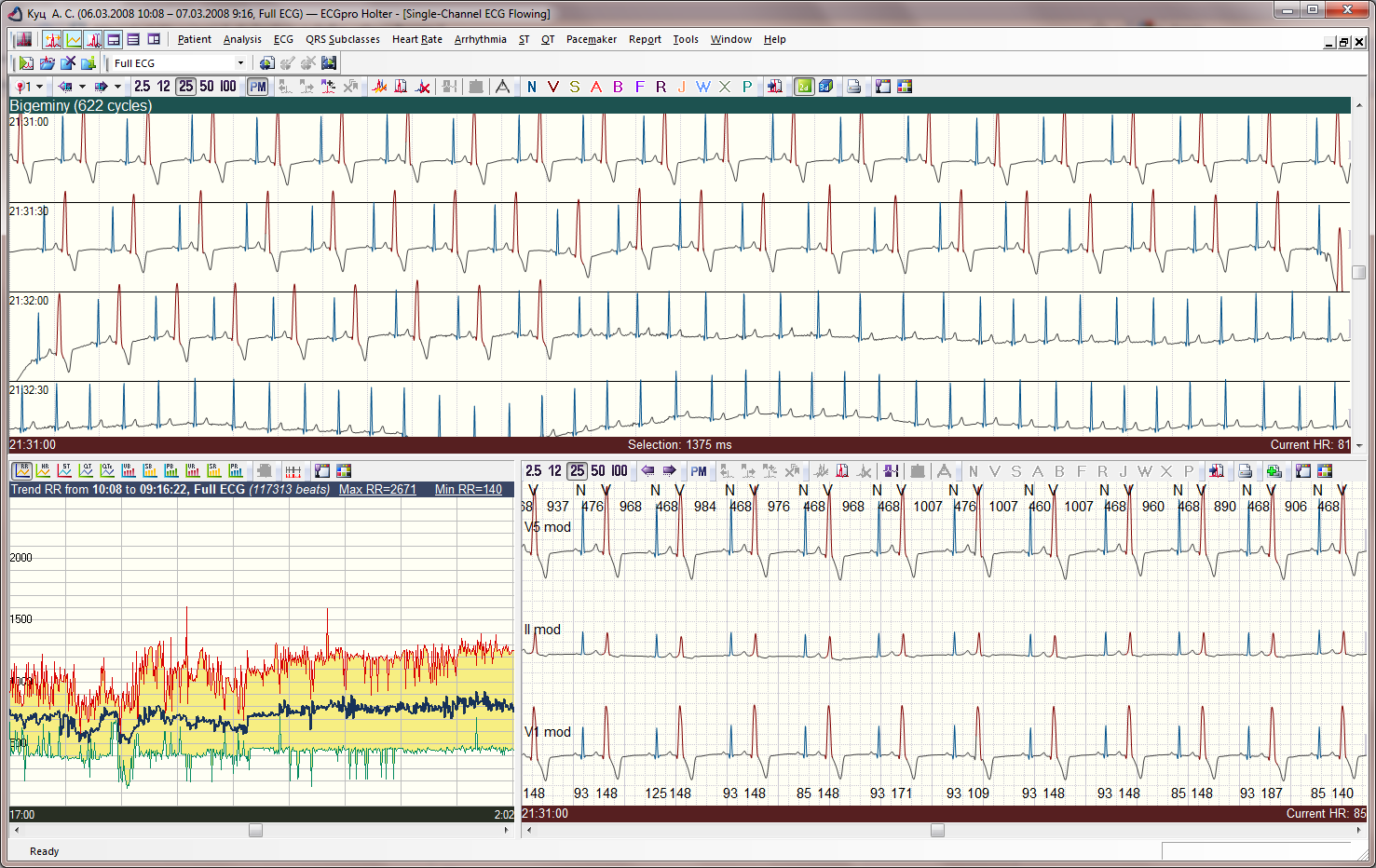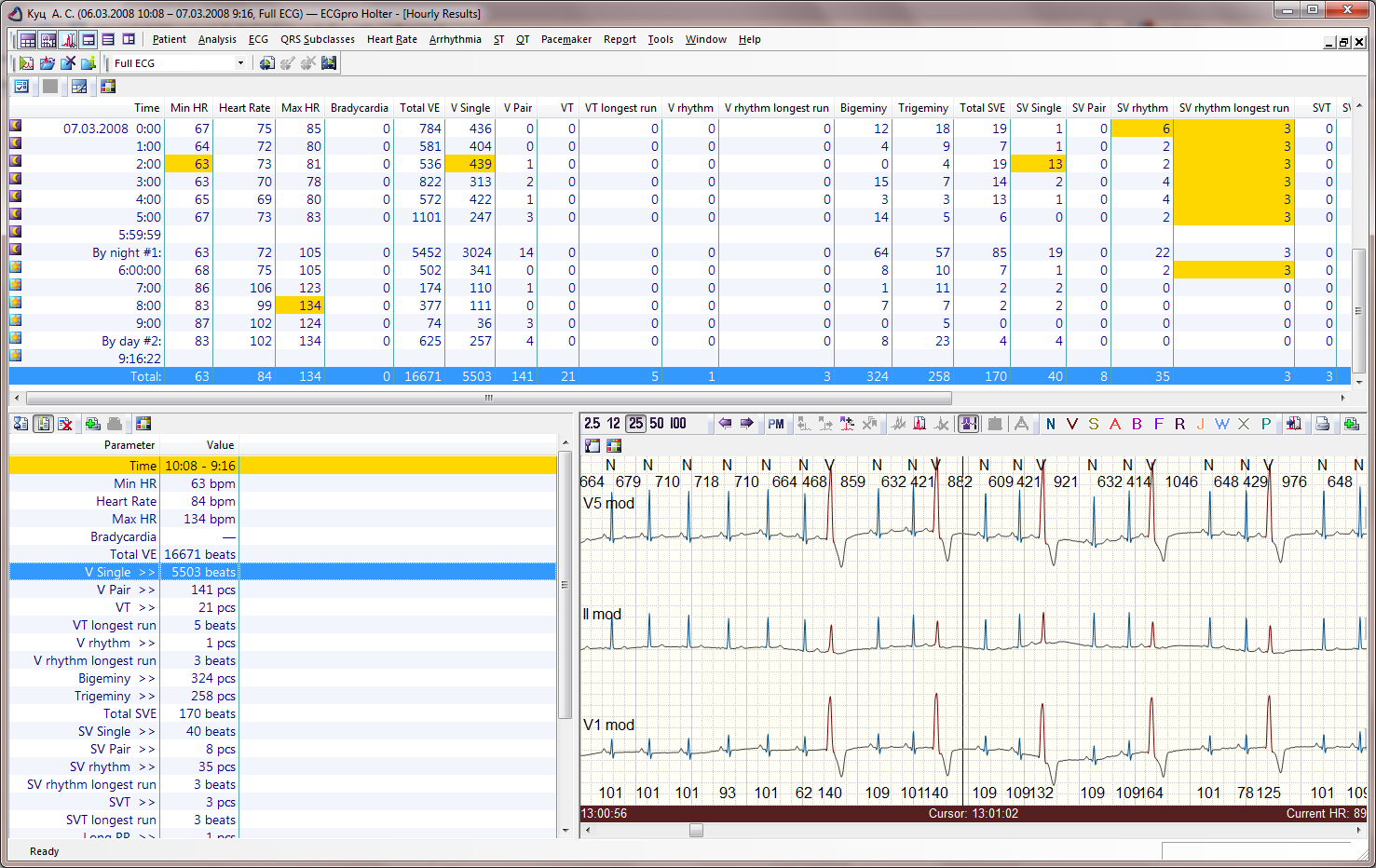Electrocardiography in Ukrainian or know ours
Modern medicine is unthinkable without modern technology. And we unconditionally attribute these same technologies to foreign countries to America or Europe. It is not strange: the ancient electrocardiographs from the neighboring hospital look ridiculous clumsy freaks alongside modern, compact and functional imported devices.
But in such a field as modern cardiography - only flowers device.
In essence, an electrocardiograph is a voltmeter with several channels and that's it. But the software ... Software is an art.
')
Imagine that a person was hooked on a portable cardiograph — he called a “Holter monitor” —to detect deviations in him that occur every two days, moreover spontaneously (transient rhythm disturbances). The cardiogram is written all two days, remains. Everyone has seen how much paper a cardiograph spends on a 10 second ECG in the nearest hospital? And now imagine that such an ECG was written for 172800 seconds. And how do you order doctors to view so many crooks, and not even miss something important? This is where modern software comes to the rescue.
His duties include analyzing the ECG and finding all abnormalities on it.
It becomes quite clear that now they are driving not rings and magic,but tank wedges and carpet bombing, but high-precision algorithms for analyzing quite complex and diverse ECG curves.
- Why do doctors? - you ask.
And despite the fact that despite the development of technology, hordes of programmers (in large companies, up to 40 programmers work on such projects), and considerable expenditure of very large and respected companies has not yet created an absolutely accurate recognition algorithm.
In general, the accuracy of the cardiogram recognition algorithm can be characterized by two parameters: sensitivity (Se) and specificity (Sp).
The calculation of these parameters is based on the statistics of mutually exclusive recognition events true positives (TP), true negatives (TN), false positives (FP) and false negativesTO resents (FN).
Se = TP / (TP + FN); Sp = TN / (TN + FP)
Simply put: sensitivity is the ability to respond to the desired element, and specificity is the ability to prevent false alarms.
The accuracy of the automated cardiogram analysis algorithm is determined during operational tests according to ANSI / AAMI EC38: 2007 and EN 60601-2-47 standards (American and European, respectively).
For this, a set of standard cardiogram databases is taken (AHA DB, MIT DB, ESC DB, NST DB, CU DB - each cardiogram is analyzed in them by a consultation of doctors and each element is described), the cardiograms are converted into a format that this particular system "eats" To be checked, the system analyzes cardiograms in a hollow automatic mode and creates an ECG description. An ideally accurate system should provide 100% matching of the description for all cardiograms in all databases. There are no such algorithms at the moment.
Official statistics, whose algorithm is more accurate, does not exist, but the industry leaders (who have something to boast of) do not hesitate to put their successes on public display. So familiarity with open sources (websites, apnotes, menus) allows you to make a comparative description of the best algorithms for automated ECG recognition:
It is then that there is reason for pride, since one of them, namely ECGpro ,from cover to cover from the smallest icon to the most complex algorithm developed by the Ukrainian company IMESC ( www.imesc.com ), has been successfully living and developing more 5 years. Here you have modern medical technologies.
Know ours!
Here are the screenshots:



But in such a field as modern cardiography - only flowers device.
In essence, an electrocardiograph is a voltmeter with several channels and that's it. But the software ... Software is an art.
')
Imagine that a person was hooked on a portable cardiograph — he called a “Holter monitor” —to detect deviations in him that occur every two days, moreover spontaneously (transient rhythm disturbances). The cardiogram is written all two days, remains. Everyone has seen how much paper a cardiograph spends on a 10 second ECG in the nearest hospital? And now imagine that such an ECG was written for 172800 seconds. And how do you order doctors to view so many crooks, and not even miss something important? This is where modern software comes to the rescue.
His duties include analyzing the ECG and finding all abnormalities on it.
It becomes quite clear that now they are driving not rings and magic,
- Why do doctors? - you ask.
And despite the fact that despite the development of technology, hordes of programmers (in large companies, up to 40 programmers work on such projects), and considerable expenditure of very large and respected companies has not yet created an absolutely accurate recognition algorithm.
In general, the accuracy of the cardiogram recognition algorithm can be characterized by two parameters: sensitivity (Se) and specificity (Sp).
The calculation of these parameters is based on the statistics of mutually exclusive recognition events true positives (TP), true negatives (TN), false positives (FP) and false negatives
Se = TP / (TP + FN); Sp = TN / (TN + FP)
Simply put: sensitivity is the ability to respond to the desired element, and specificity is the ability to prevent false alarms.
The accuracy of the automated cardiogram analysis algorithm is determined during operational tests according to ANSI / AAMI EC38: 2007 and EN 60601-2-47 standards (American and European, respectively).
For this, a set of standard cardiogram databases is taken (AHA DB, MIT DB, ESC DB, NST DB, CU DB - each cardiogram is analyzed in them by a consultation of doctors and each element is described), the cardiograms are converted into a format that this particular system "eats" To be checked, the system analyzes cardiograms in a hollow automatic mode and creates an ECG description. An ideally accurate system should provide 100% matching of the description for all cardiograms in all databases. There are no such algorithms at the moment.
Official statistics, whose algorithm is more accurate, does not exist, but the industry leaders (who have something to boast of) do not hesitate to put their successes on public display. So familiarity with open sources (websites, apnotes, menus) allows you to make a comparative description of the best algorithms for automated ECG recognition:
| Analysis accuracy,% | |||||
|---|---|---|---|---|---|
| IMESC ECGpro | Mortara Veritas | Agilent ST / AR | Medilog ADAPT | Spacelabs Multiview | |
| MIT-BIH | |||||
| Q Se | 99.92 | 99.93 | 99.66 | 99.87 | 99.82 |
| Q Sp | 99.88 | 99.85 | 99.86 | 99.91 | 99.85 |
| AHA | |||||
| Q Se | 99.84 | 99.88 | 99.80 | 99.90 | 99.76 |
| Q Sp | 99.80 | 99.89 | 99.87 | 99.90 | 99.87 |
It is then that there is reason for pride, since one of them, namely ECGpro ,
Know ours!
Here are the screenshots:



Source: https://habr.com/ru/post/104294/
All Articles